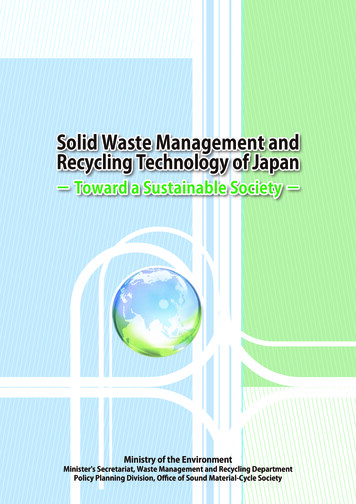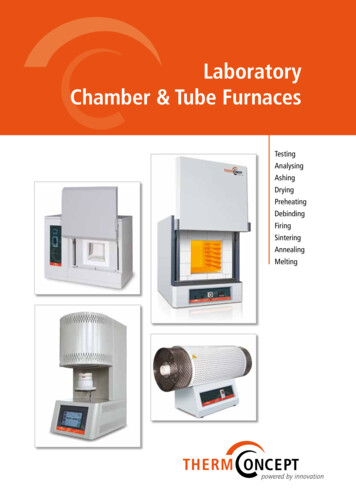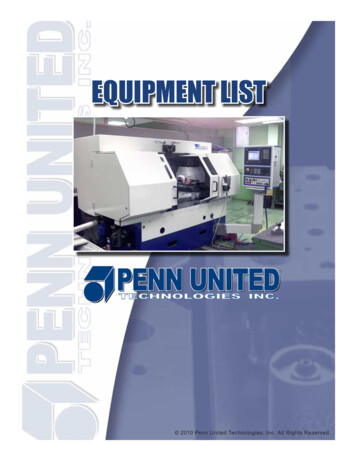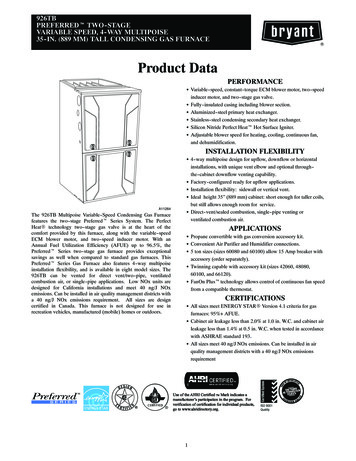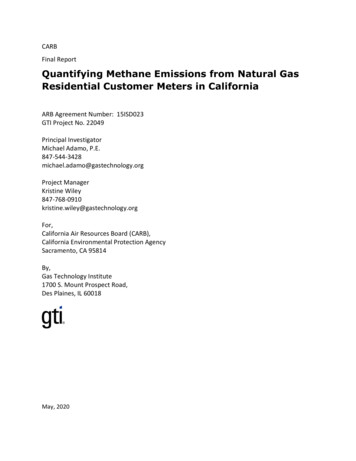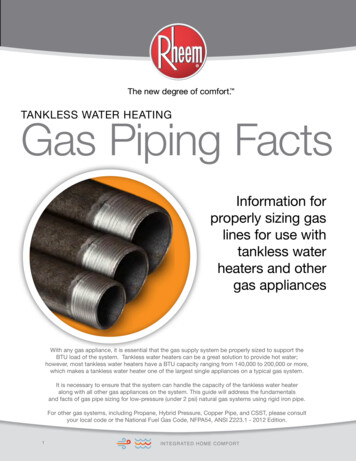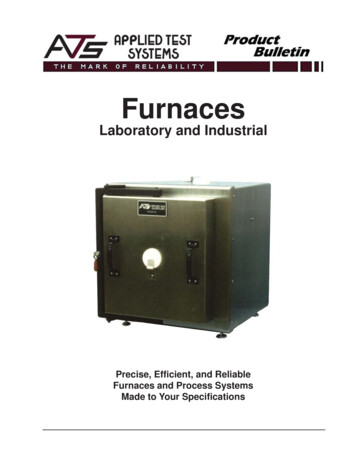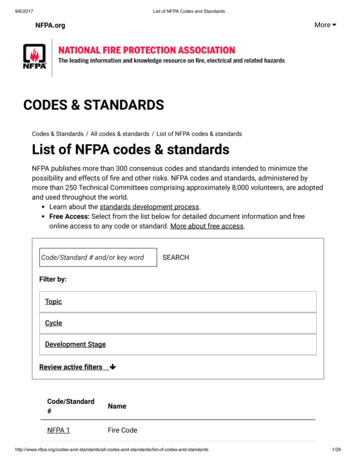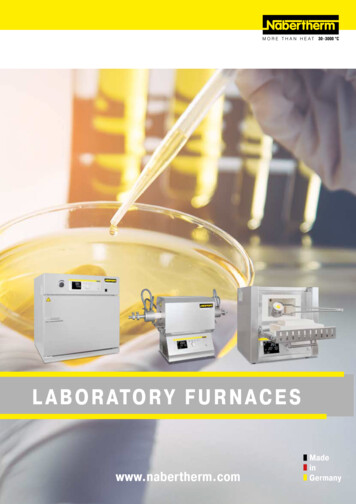
Transcription
Residential Two-Stage Gas Furnaces: Do They Save Energy?Alex Lekov, Victor Franco, and James LutzLawrence Berkeley National LaboratoryABSTRACTResidential two-stage gas furnaces account for almost a quarter of the total number ofmodels listed in the March 2005 GAMA directory of equipment certified for sale in the UnitedStates. Two-stage furnaces are expanding their presence in the market mostly because they meetconsumer expectations for improved comfort.Currently, the U.S. Department of Energy (DOE) test procedure serves as the method forreporting furnace total fuel and electricity consumption under laboratory conditions. In 2006,American Society of Heating, Refrigeration and Air-Conditioning Engineers (ASHRAE)proposed an update to its test procedure which corrects some of the discrepancies found in theDOE test procedure and provides an improved methodology for calculating the energyconsumption of two-stage furnaces.The objectives of this paper are to explore the differences in the methods for calculatingtwo-stage residential gas furnace energy consumption in the DOE test procedure and in the 2006ASHRAE test procedure and to compare test results to research results from field tests. Overall,the DOE test procedure shows a reduction in the total site energy consumption of about 3% fortwo-stage compared to single-stage furnaces at the same efficiency level. In contrast, the 2006ASHRAE test procedure shows almost no difference in the total site energy consumption. The2006 ASHRAE test procedure appears to provide a better methodology for calculating theenergy consumption of two-stage furnaces. The results indicate that, although two-stagetechnology by itself does not save site energy, the combination of two-stage furnaces with BPMmotors provides electricity savings, which are confirmed by field studies.IntroductionA residential gas furnace can be designed with single-stage controls or modulatingcontrols. There are two different types of modulating controls which can be applied to furnaces,two-stage or step-modulation controls. In this paper, we examine only modulation with two-stagecontrols, which accounts for the large majority of the modulating furnaces. A two-stage furnacerequires all or some of the following components: a two-stage gas valve, two-stage controls, amultiple speed blower motor, and two-speed inducer motor. A two-stage control is any controlthat uses a two-stage adjustment of the furnace input rate in response to changes in the heatingload. Based on thermostat demand, the two-stage control cycles the burners between a reducedheat input rate and off or between the maximum heat input rate and off.Two-stage furnaces use two types of blower motor designs: permanent split capacitor(PSC) and brushless permanent magnet (BPM)1. PSC motors are reasonably efficient whenoperating at high speed, however, when these motors are operated at low speed, their efficiencies1 BPM motors are also known as Electronically Commutated Motors (ECM) which is a registered trademark ofGeneral Electric. 2006 ACEEE Summer Study on Energy Efficiency in Buildings1-175
drop significantly. Overall, BPM motors are more suitable in two-stage designs because theyoffer much higher efficiencies at lower speeds than PSC motors. Almost all BPM motors areused in two-stage furnaces (DOE 2004; Habart 2005; Kendall 2004).Two-stage gas furnaces account for almost a quarter of the total number of models in theMarch 2005 GAMA directory of certified equipment for sale in the United States (GAMA 2005).Although an exact estimate of the market share of two-stage furnace is not known, they areexpanding their presence in the market place mostly because they meet consumer expectationsfor improved comfort (Carrier 2004; Lennox 2005). Furnaces that operate at substantiallyreduced output over longer periods of time can provide more uniform space temperatures, quieteroperation, greater efficiency, and reduced emissions. In addition, financial incentives introducedto decrease the electricity consumption of furnaces, mainly by providing incentives for the use ofBPM motors, have been shown to increase the market share of two-stage furnaces with BPMmotors in Oregon, Wisconsin, and British Colombia (Habart 2005). The gas furnace taxincentives in Energy Policy Act of 2005 (EPAct 2005)2 should have a similar effect.Due to the increasing interest in two-stage furnaces, it becomes important to moreaccurately calculate the energy consumption in order to assess the potential energy savings ofthese furnaces compared to other furnace design options.The current U.S. Department of Energy (DOE) test procedure (DOE 2006), which isbased on American Society of Heating Refrigeration and Air-conditioning Engineers (ASHRAE)Standard 103-93 (ASHRAE 1993), has served as the method for reporting furnace total fuel andelectricity consumption under laboratory conditions as well as Annual Fuel UtilizationEfficiency (AFUE). The test results are then reported in a GAMA directory and are frequentlyused as a basis for comparing energy consumption between furnace models, calculating potentialenergy savings, and determining which furnace models should receive incentives.In 2006, American Society of Heating Refrigeration and Air-conditioning Engineers(ASHRAE) proposed an update of its test procedure (ASHRAE 2006) to include modificationsbased on research conducted during the last several years (Stanley 2002). This new testprocedure corrects some of the discrepancies found in the DOE test procedure and also providesa more accurate basis for the estimation of the energy consumption of two-stage furnaces.This paper explores the differences in the methods for calculating two-stage residentialgas furnace energy consumption in the DOE test procedure and in the 2006 ASHRAE testprocedures and compares it to research results from field studies. The results from comparing thetest procedures are significantly different and this paper attempts to summarize these results andpoint to the reasons for the differences.Methodology for Determining Two-Stage Furnace Energy ConsumptionFigure 1 illustrates the basic parameters and methodology used in the DOE and 2006ASHRAE test procedure to calculate fuel and electricity consumption of gas furnaces. Theaverage annual fuel consumption of furnaces (EF) and the annual auxiliary electrical energy(EAE) are frequently used as furnace performance metrics.2 Most furnace models that meet current requirements for tax credits under EPAct 2005 are two-stage furnaces.EPAct 2005 provides tax incentives for consumers that either purchase furnace having an AFUE of 95% or greateror a furnace with an efficient blower motor that consumes less than or equal to 2% of the total site energyconsumption of the furnace. 2006 ACEEE Summer Study on Energy Efficiency in Buildings1-176
Figure 1. Fuel Consumption Calculation for Gas Furnaces in theDOE and 2006 ASHRAE Test ntsFuel Input RateMaximumor ReducedModeHeat fromFuelBurnerOperating HoursHeat ed byOn-time RatiosFuelConsumptionElectricityConsumptionTo satisfy the households heating requirements, the furnace operates at only themaximum operating mode if it has single-stage controls or a combination of the maximum andreduced operating mode if it has two-stage controls. The test procedures determine the ratio oftime the furnace is operating at the reduced or maximum operating mode in two-stage furnacesby calculating an operating mode factor that uses the average outdoor temperature at which thefurnace starts operating (65ºF), the typical outdoor design temperature (5ºF), and is a function ofthe oversize factor and the ratio of the reduced input rate to the maximum input rate.The furnace fuel consumption is a function of the burner operating hours and the fuelinput rate. The burner operating hours are determined by calculating the household heatingrequirements and the heat provided by the furnace fuel and the furnace electrical components.The household hearting requirements are a function of an oversize factor and the furnaceoutput capacity and use the national average heating load hours corrected for the operatingconditions. The household heating requirements are satisfied by the furnace fuel and by heatgenerated by some of the furnace electrical components. Furthermore, the operating length ofelectrical components can differ from the operating length of the burner. For example, thefurnace blower usually operates 10-30% longer than the burner to scavenge residual heat fromthe heat exchanger. This difference is calculated using on-time ratios for the individual electricalcomponents.Similarly, electricity consumption is a function of the burner operating hours adjusted byon-time ratios and the electricity use of the furnace electrical components. The burner operating 2006 ACEEE Summer Study on Energy Efficiency in Buildings1-177
hours are adjusted by on-time ratios to account for the differences in the operating lengthbetween the electrical components and the burner.Neither test procedure accounts for standby power, which may amount to about 10% ofthe electricity used by furnaces (Pigg 2003). Furthermore, neither test procedure accounts for theelectricity consumption by the blower for its air-conditioning operation during the coolingseason. In fact, the furnace blower serves also as an air handler for the air conditioner and anyefficiency improvement affecting the blower will also provide electricity savings during thecooling season.Using the calculation methods described in these two test procedures, this papercalculates the fuel and electricity consumption for 12 design configurations that are divided intofour efficiency levels and both single stage and two-stage control strategies. Furnaces with twostage controls were evaluated with both PSC and BPM motors. The 80% and 81% AFUEefficiency levels represent non-condensing furnaces. The 90% and 95% AFUE efficiency levelrepresent condensing furnaces.The assumptions used in this paper to compare the test procedures are listed in Table 2.Table 2. Assumptions Used to Compare the Energy Consumption MethodsBetween the Two Test ProceduresParametersMaximum fuel input rateReduced fuel input rateAFUEHeating RequirementsElectrical ComponentsPSC Motor ElectricityBPM Motor ElectricityDraft Inducer ElectricityIgnition DeviceElectricityAssumptions75 kBtu/hr68% of the maximum fuel input rate (based on manufacturer product literatureand GAMA’s March 2005 directory)AFUE at both the maximum and reduced operating mode is the same for each testprocedure (DOE 2004; Habart 2005)Heating Requirements are set constant regardless of AFUE level. (This isequivalent to assuming that furnaces having the same input capacities, butdifferent efficiencies, serve a house with a constant design heating requirement.)Blower electricity and ignitor power are used to calculate the heat generated bythe furnace electrical components, while the furnace blower, draft inducer, andthe ignition device are used to calculate the electricity consumption for both testprocedures.500 watts at the maximum operating mode (Jakob et al. 1994).398 watts at the maximum operating mode (DOE 2004).76 watts at all operating modes (DOE 2004).400 watts at all operating modes (DOE 2004).As shown in Table 2, we assume that a PSC motor would operate at 500 watts at themaximum operating mode (Jakob et al. 1994) and 80% of this at the reduced operating mode.We assume BPM motors to be 20.4% more efficient than PSC motors (DOE 2004) and thereforeoperate at 398 watts at the maximum operating mode and 50% of this at the reduced operatingmode.Note that the static pressure used in the test procedures to calculate the electricityconsumption of furnace blowers is not consistent with field data, where the furnaces tend tooperate at a higher static pressure (Chitwood 2005; Phillips 1998; Pigg 2003). Using a higherstatic pressure will in general increase electricity consumption by BPM motors, whilemaintaining air moving performance, and decrease the electricity consumption by PSC motors,while decreasing air moving performance (Walker et al. 2003). 2006 ACEEE Summer Study on Energy Efficiency in Buildings1-178
Test Procedure ComparisonTable 3 summarizes the main differences between the DOE test procedure and the 2006ASHRAE test procedures when calculating two-stage residential gas furnace energyconsumption.Table 3. Summary of Differences between Two Test Procedures for Calculating EnergyConsumption by Two-Stage Natural Gas FurnacesParameterFuel ConsumptionElectricityConsumptionBurner OperatingHours (BOH)Household HeatingRequirementsOperating ModeFactorHeat from FuelHeat from ElectricityOn-time ratiosElectrical ComponentsContribution2006 DOE Test ProcedureCalculated at the maximum operatingmode only.Calculated at the maximum and reducedoperating mode.BOH at the reduced operating mode is afunction of BOH at the maximumoperating mode adjusted by a ratio of thereduced and maximum fuel input rates.Uses Design Heating Requirement (DHR),which is a step function of outputcapacity.Factor from reference table. A stepfunction, since the oversize factor dependson DHR.Only uses the fuel input rate and furnaceAFUE at the maximum operating modeCalculated at the maximum operatingmode only.Uses fixed on-time ratios at the maximumoperating mode. A correction factor isused in calculating BOH to compensatefor longer use of electrical components.Blower electricity and ignitor power areused to calculate the heat generated by thefurnace electrical components, while thefurnace blower, draft inducer, and theignition device are used to calculate theelectricity consumption for both testprocedures.2006 ASHRAE Test ProcedureCalculated at both the maximum andreduced operating mode.Accounts for on-time ratios at thereduced operating mode.Maximum and reduced operatingmodes calculated separately.Replaces DHR with a linear functiondependent on output capacity andfixed oversize factor.Factor calculated directly using alinear function of output capacity andfixed oversize factor.Uses the fuel input rate and furnaceAFUE at both the maximum andreduced operating modeDetermined at the maximum andreduced operating mode.Variable on-time ratios that aredetermined at the maximum andreduced operating mode. Noadditional correction factor is used.Ignition device heat and electricitycontribution not calculated.Since the 2006 ASHRAE test procedure takes into account burner operating hours andinput capacities at both maximum and reduced operating modes, it better matches the field datathat show that two-stage furnaces operate predominately at the reduced operating mode (DOE2004; Habart 2005; Pigg 2003). The electricity consumption calculations in the 2006 ASHRAEtest procedure provides a more accurate determination of the on-time ratios at the maximum andreduced operating mode than in the DOE test procedure. Therefore, the 2006 ASHRAE testprocedure provides a more accurate basis for estimating both fuel and electricity consumption.The calculation of the burner operating hours for two-stage furnaces differs between thetest procedures. In the DOE test procedure, the burner operating hours at the reduced operatingmode are a function of the burner operating hours at the maximum operating mode and a ratio of 2006 ACEEE Summer Study on Energy Efficiency in Buildings1-179
the maximum to reduced input fuel rate. In the 2006 ASHRAE test procedure, the burneroperating hours are calculated independently for the maximum and reduced operating mode.In the DOE test procedure, the heating requirements of the house used to calculate theburner operating hours are determined using the Design Heating Requirement (DHR) parameter.DHR is also used to apportion the annual heating load between the reduced and maximumoperating mode for two-stage furnaces. DHR is a step function of furnace heating capacity and asmall rise in the heating capacity impacts DHR value in a way that results in higher energyconsumption for more efficient furnaces. This causes the DOE test procedure methodology to notalways be suitable for comparing furnace energy use. The 2006 ASHRAE test procedurereplaces DHR with a linear function that includes the heating capacity at the maximum andreduced operating mode and a constant oversize factor.Burner Operating Hours are corrected both by the heat provided by the fuel and by theheat from electrical components. In the DOE test procedure, the heat from the electricalcomponents and the cycling rates are calculated at the maximum operating mode only. Inpractice, two-stage furnaces operate most of the time in the reduced mode, which lengthens thefurnace operation. To compensate for this, the DOE test procedure applies a factor that reflectsthe ratio of on-time for the two-stage furnace versus the single-stage furnace. This factor is notincluded in the 2006 ASHRAE test procedure, since electricity consumption and the on-timeratios are calculated separately for the maximum and reduced modes. This approach reduces thefraction of heat from the electricity components.Energy Consumption ResultsWe report the results from a study that analysis the fuel and electricity consumption ofdifferent AFUE levels, controls, and motor types. This paper separately looks at the impact of thefuel and electricity consumption for a sample of furnace design configurations. It also looks atthe total energy consumption for several efficiency levels.As a sample, Figure 2 shows the fuel energy consumption results at 80% AFUE for thefollowing configurations: single stage with PSC, two-stage with BPM, and two-stage with BPM.For single-stage controls both test procedures show the same fuel consumption. The DOE testprocedure shows fuel savings of 3.4% for two-stage furnaces with PSC motors compared tosingle stage furnaces, while the 2006 ASHRAE test procedure shows only a 0.4% decrease infuel consumption. The DOE test procedure shows fuel savings of 2.1% for two-stage furnaceswith BPM motors compared to single stage furnaces, while the 2006 ASHRAE test procedureshows a 1.4% increase in fuel consumption. The 2006 ASHRAE test procedure shows a 3%higher fuel consumption for a two-stage furnace with a BMP motor as compared to the DOE testprocedure due to a more accurate calculation approach, which decreases the heat contributionfrom the electrical components. Furthermore, both test procedures show a 1-2% higher fuelconsumption for two-stage furnaces with BPM motors than for those with PSC motors, sinceBPM motors are more efficient than PSC motors and therefore generate less heat, which wouldotherwise contribute to satisfying the heating requirements. 2006 ACEEE Summer Study on Energy Efficiency in Buildings1-180
Figure 2. Fuel Consumption Comparison90DOE Test ProcedureFuel Consumption (MMBtu/y)2006 ASHRAE Test Procedure8070605080% AFUE(Single-Stage, PSC)80% AFUE(Two-stage, PSC)80% AFUE(Two-stage, BPM)Control/Motor TypeA field study in Canada showed an increase in fuel consumption for furnaces with BPMmotors (Gusdorf 2002), which is in line with the increased fuel consumption calculated based onthe 2006 ASHRAE test procedure.Figure 3 shows the electricity consumption results. For single-stage controls the two testprocedures show no differences in the electricity consumption. The DOE test procedure showsan electricity consumption increase of 2.0% for two-stage furnaces with PSC motors comparedto single stage furnaces, while the 2006 ASHRAE test procedure shows a 11.4% increase inelectricity consumption. The DOE test procedure shows electricity savings of 39.8% for twostage furnaces with BPM motor compared to single stage furnaces, while the 2006 ASHRAE testprocedure shows only a 33.5% decrease in electricity consumption. The 9-10% increase in the2006 ASHRAE test procedure electricity consumption for two-stage furnaces with the samemotor as compared to the DOE test procedure is mainly due to an increase in the period ofblower operation compared to the burner operation at the reduced operating mode. Furthermore,both test procedures show a 40-41% electricity consumption decrease for two-stage furnaceswith BPM motors compared to those with PSC motors. Even though two-stage furnaces withBPM motors have more operating hours than two-stage furnaces with PSC motors, BPM motorsare much more efficient than PSC motors at the reduced operating mode. 2006 ACEEE Summer Study on Energy Efficiency in Buildings1-181
Figure 3. Electricity Consumption ComparisonElectricity Consumption (kWh/year)900DOE Test Procedure8002006 ASHRAE Test Procedure700600500400300200100080% AFUE(Single-Stage, PSC)80% AFUE(Two-stage, PSC)80% AFUE(Two-stage, BPM)Control/Motor TypeA field study in Wisconsin showed a 40% decrease in electricity consumption forfurnaces with BPM motors (Pigg 2003) compared to furnaces using PSC motors. This is in linewith the results based on the DOE and 2006 ASHRAE test procedures.Figure 4 shows the combined fuel and electricity consumption using the calculationmethods described in the DOE test procedure and the 2006 ASHRAE test procedure for severalfurnace efficiency levels (80%, 81%, 90%, and 95% AFUE), that represent non-condensing andcondensing furnaces. For two-stage designs, the DOE test procedure consistently shows areduction in energy consumption by about 3% compared to single-stage furnaces at the sameAFUE level. In contrast, the 2006 AHRAE test procedure shows almost no difference in the totalenergy consumption at the same efficiency level. The reason is that although two-stage furnacesoperate longer at the reduced mode, this is offset by lower fuel input rate at this mode.In the 2006 ASHRAE test procedure the results for single-stage as well as for two-stagefurnaces show that a one percent change in AFUE results in about the same percent reduction inthe total energy consumption. In contrast, the DOE test procedure for two-stage furnaces showsabout a 4% decrease in total energy consumption for a 1% percent AFUE change. The 2006ASHRAE test procedure offers a more accurate method for calculating the energy consumptionof two-stage furnaces. 2006 ACEEE Summer Study on Energy Efficiency in Buildings1-182
Figure 4. Total Energy Consumption at Various AFUE LevelsDOE Test Procedure2006 ASHRAE Test Procedure807095% AFUE(Two-stage, BPM)95% AFUE(Two-stage, PSC)95% AFUE(Single-Stage, PSC)90% AFUE(Two-stage, BPM)90% AFUE(Two-stage, PSC)90% AFUE(Single-Stage, PSC)81% AFUE(Two-stage, BPM)81% AFUE(Two-stage, PSC)81% AFUE(Single-Stage, PSC)80% AFUE(Two-stage, BPM)5080% AFUE(Two-stage, PSC)6080% AFUE(Single-Stage, PSC)Total Energy Consumption (MMBtu/y)90AFUE and Control/Motor TypeNote that although the energy consumption of two-stage furnaces is about the same asthat of single-stage furnaces, the consumer using a two-stage design with a BPM motors will stillbenefit financially, because they would reduce use of the more expensive electricity (Sachs andSmith 2004).ConclusionsThis paper presents furnace energy consumption calculations based on the current DOEtest procedure and the 2006 ASHRAE test procedure. It also includes a summary of themethodology used in both test procedures to determine the energy consumption of two-stagefurnaces. A detailed comparison of the differences between the two procedures is also presented.The DOE test procedure shows fuel savings of 3.4% for two-stage furnaces relative tosingle-stage furnaces at the same AFUE, while the 2006 ASHRAE test procedure shows only a0.4% decrease in fuel consumption. The electricity consumption of two-stage furnaces asopposed to single-stage furnaces increases by 11% in the 2006 ASHRAE test procedure asopposed to a 2% increase in the DOE test procedure. Overall, the DOE test procedure shows areduction in the total energy consumption of about 3% for two-stage furnaces at the sameefficiency level. In contrast, the 2006 ASHRAE test procedure shows almost no difference in thetotal energy consumption. The 2006 ASHRAE test procedure results seem to be confirmed byfield studies. This study also provides a comparison of the energy consumption among differentefficiency levels. The results show that a change of AFUE produces an equivalent reduction inthe total energy consumption in the 2006 ASHRAE test procedure calculations.This paper shows that the main improvements in the 2006 ASHRAE test procedure are:(a) the approach used to calculate the heat generated by the furnace’s electrical components (b)the approach for calculating on-time ratios for the furnace’s electrical components, (c) properly 2006 ACEEE Summer Study on Energy Efficiency in Buildings1-183
accounting for maximum and reduced operating modes, and (d) the approach used to determinethe design heating requirement.Based on the 2006 ASHRAE test procedure, which appears to provide a more accuratemethod for calculating the energy consumption of two-stage furnaces, the results indicate thattwo-stage technology by itself does not save energy. However, the combination of two-stagefurnaces with BPM motors provides electricity savings and overall financial benefits to theconsumers.References[ASHRAE] American Society of Heating Refrigerating and Air-Conditioning Engineers. 1993.“Method of Testing for Annual Fuel Utilization Efficiency of Residential CentralFurnaces and Boilers.” ANSI/ASHRAE 103/1993. Atlanta, Ga.: American Society ofHeating Refrigerating and Air-Conditioning Engineers.———. 2006. “Public Review of Method of Testing for Annual Fuel Utilization Efficiency ofResidential Central Furnaces and Boilers.” BSR/ASHRAE Standard 103-1993R. Atlanta,Ga.: American Society of Heating Refrigerating and Air-Conditioning Engineers.[Carrier] Carrier Corporation. 2004. Infinity 80 Gas Furnace Consumer Brochure. February uments/marketing/858-436-021804.pdfFarmington, Conn.: Carrier Corporation.Chitwood, Rick. 2005. Personal Communication. Raw Data of Airflow Tests Conducted inCalifornia Houses for CEC 2008 Residential Standards Research, CN500-04-006,September. Mt. Shasta, Calif.: Chitwood Energy Management.[DOE] U.S. Department of Energy. 2004. Energy Conservation Program for Consumer Products:Energy Conservation Standards for Residential Furnaces and Boilers; Proposed RuleFurnace and Boiler Advanced Notice of Proposed Rule (ANOPR). July 29.http://www.eere.energy.gov/buildings/appliance standards/residential/furnaces boilers.html Washington, D.C.: U.S. Department of Energy.———. 2006. 10 Code of Federal Regulations, Part 430-Subpart B Appendix N—Uniform TestMethod for Measuring the Energy Consumption of Furnaces and Boilers. January 1.Washington, D.C.: U.S. Department of Energy.[GAMA] Gas Appliance Manufacturers Association. 2005. Consumers’ Directory of CertifiedEfficiency Ratings for Heating and Water Heating Equipment. March. Arlington, Va.:Gas Appliance Manufacturers Association. 2006 ACEEE Summer Study on Energy Efficiency in Buildings1-184
Gusdorf, J., M.C. Swinton, E. Entchev, C. Simpson, and B. Castellan. 2002. “The impact ofECM furnace motors on natural gas use and overall energy use during the heating seasonof CCHT research facility.” Gas Technology Institute’s First Natural Gas TechnologiesConference and Exhibition, Orlando, Fla., September 29-October 2. 443.pdf Ottawa, Canada: Canadian Centre forHousing Technology out/library/reports/0508 GasFurnaceMarketAssessment.pdf Portland, Ore.: Energy Trust of Oregon.Jakob, F. E., J. J. Crisafulli, J. R. Menkedick, R. D. Fischer, D. B. Philips, R. L. Osbone, J.C.Cross, G. R. Whitacre, J. G. Murray, W. J. Sheppard, D. W. DeWirth, and W. H.Thrasher. 1994. Assessment of Technology for Improving the Efficiency of ResidentialGas Furnaces and Boilers, Volume I and II – Appendices, GRI-94/0175. September.Chicago, Ill.: Gas Research Institute, AGA Laboratories.Kendall, Mark A. 2004. “Energy-Saving Opportunities in Residential Air-Handler Efficiency.”ASHRAE Transactions, V. 110, Pt.1. Atlanta, Ga.: American Society of Heating,Refrigerating and Air-Conditioning Engineers.[Lennox] Lennox Industries, Inc. 2005. G60V Gas Furnace Product Brochure. VGasFurnace.pdf Richardson, Tex.:Lennox Industries, Inc.Phillips, Bert G. 1998. “Impact of Blower Performance on Residential Forced-Air HeatingSystem Performance.” ASHRAE Transactions, V. 104, Pt.1. Atlanta, Ga.: AmericanSociety of Heating, Refrigerating and Air-Conditioning Engineers.Pigg, Scott. 2003. “Electricity Use by New Furnaces: A Wisconsin Study.” Madison, Wis.:Energy Center of Wisconsin.Sachs, H. M., and S. Smith. 2004. “How Much Energy Could Residential Furnace Air HandlersSave?” ASHRAE Transactions, V. 110, Pt.1. Atlanta, Ga.: American Society of Heating,Refrigerating and Air-Conditioning Engineers.Stanely, Liu. 2002. Proposed Revisions of Part of the Test Procedure for Furnaces and Boilers inASHRAE Standard 103-1993. September. Gaithersburg, Md.: U.S. Department ofCommerce, National Institute of Standards and Technology, Building EnvironmentDivision, Building and Fire Research Laboratory.Walker, Ian, M.D. Mingee, and D.E. Brenner. 2003. “Improving Air Handler Efficiency inResidential HVAC Applications,” LBNL 53606, August. Berkeley, Calif.: LawrenceBerkeley National Laboratory. 2006 ACEEE Summer Study on Energy Efficiency in Buildings1-185
2 Most furnace models that meet current requirements for tax credits under EPAct 2005 are two-stage furnaces. EPAct 2005 provides tax incentives for consumers that either purchase furnace having an AFUE of 95% or greater or a furnace with an efficient blower motor that consumes less than or equal to 2% of the total site energy
